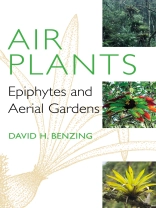Often growing far above the ground, ‘air plants’ (or epiphytes) defy many of our common perceptions about plants. The majority use their roots only for attachment in the crowns of larger, usually woody plants—or to objects such as rocks and buildings—and derive moisture and nutrients from the atmosphere and by collecting falling debris. Only the mistletoes are true parasites. Epiphytes are not anomalies and there are approximately 28, 000 species—about 10 percent of the higher or vascular plants—that grow this way. Many popular houseplants, including numerous aroids, bromeliads, ferns, and orchids, rank among the most familiar examples. In Air Plants, David H. Benzing takes a reader on a tour of the many taxonomic groups to which the epiphytes belong and explains in nontechnical language the anatomical and physiological adaptations that allow these plants to conserve water, thrive without the benefit of soil, and engage in unusual relationships with animals such as frogs and ants.
Benzing’s comprehensive account covers topics including ecology, evolution, photosynthesis and water relations, mineral nutrition, reproduction, and the nature of the forest canopy as habitat for the free-living and parasitic epiphytes. It also pays special attention to important phenomena such as adaptive trade-offs and leaf economics. Drawing on the author’s deep experience with epiphytes and the latest scientific research, this book is accessible to readers unfamiliar with technical botany; it features a lavish illustration program, references, a glossary, and tables.
Table of Content
1. What Is an Epiphyte?
Getting to Know the Epiphytes
Body Plans
The Epidermis
Other Notable Features of the Epiphytes
Starting at the Beginning
Geological History
Geographic Distribution
Use by Humans
Conservation 2. The Types of Epiphytes and Their Evolutionary Origins
The Free-Living Epiphytes
The Biological Underpinnings of Epiphytism
How Epiphytism Evolved
The Taxonomic Affiliations of the Epiphytes
Genetic Heritage and Evolutionary Options
Epiphytism and Speciation 3. Epiphytes in Communities and Ecosystems
The Nature of Aerial Habitats
Mineral Nutrients
Water
Light
Epiphytes as Members of Communities
Random Factors Also Structure Communities
Ecological Succession
What Makes a Tree a Host for Epiphytes?
How Epiphytes Can Impact Their Hosts
Nutritional Piracy
Additional Ways That Epiphytes Harm Their Hosts
Manifold Effects on Ecosystems 4. Water Management
Variations on Basic Themes
How Biological Structure Relates to Function
Water Management
How Epiphytes Cope with Drought
Drought Avoidance
Leaf Economics
Roots
Leaves as Proxies for Roots 5. Photosynthesis and Mineral Nutrition
The Photosynthetic Syndromes
C3 versus CAM-type Photosynthesis
Light and Adaptive Growth
Mineral Nutrition
The Mistletoes 6. Reproduction and Other Interactions with Animals
Pollination
Fruits and Seeds
Asexual Reproduction
Plant Defenses
Ants and Epiphytes
Termites
Leafy Tanks and Phytotelms
Case Studies 7. The Epiphytic Monocots
Orchidaceae
The Vegetative Body
Reproduction and Speciation
The Adaptive Types
Bromeliaceae
Bromeliads versus Orchids
Adaptations for Epiphytism
Hemi-epiphytism
The Atmospheric Bromeliads
Araceae
Amaryllidaceae and Additional Families in Order Liliales 8. The Epiphytic Eudicots
Cactaceae
General Characteristics
Adaptations for Epiphytism
Evolutionary History
Ecology
Reproduction
Ericaceae
Adaptations for Epiphytism
Epiphytism and Speciation
Reproductive Biology
Horticulture
Gesneriaceae
Adaptive Variety
Evolutionary History
Reproductive Biology
Rubiaceae
Melastomataceae
Apocynaceae
Solanaceae 9. The Pteridophytic Epiphytes
The Major Groups of Pteridophytes
The Ferns
The Lycophytes 10. Miscellaneous Epiphytes
Piperaceae
The Carnivorous Epiphytes
The Stranglers and Other Primary Hemi-epiphytes
The Gymnosperms
Additional Oddities 11. Threats and Conservation
How Epiphytes Influence Microclimates
Contributions to Biodiversity
Global Change
Excess Nutrients
Plant Invasions
Habitat LossGlossary
References
Subject Index
Taxon Index












